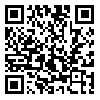Volume 19, Issue 1 (6-2021)
sjsph 2021, 19(1): 21-34 |
Back to browse issues page
Download citation:
BibTeX | RIS | EndNote | Medlars | ProCite | Reference Manager | RefWorks
Send citation to:



BibTeX | RIS | EndNote | Medlars | ProCite | Reference Manager | RefWorks
Send citation to:
Motesadi Zarandi S, Nasiri R, Motlagh M E. Modeling of the Relationships Between Spatio-Temporal Changes of Traffic Volume and Particulate Matter-2.5 Pollutant Concentration Based on Geographically Weighted Regression (GWR) and Inverse Distance Weighting (IDW) Model: A Case Study in Tehran Metropolis, Iran. sjsph 2021; 19 (1) :21-34
URL: http://sjsph.tums.ac.ir/article-1-5991-en.html
URL: http://sjsph.tums.ac.ir/article-1-5991-en.html
1- , nasirirasul@gmail.com
Abstract: (2073 Views)
Background and Aim: High concentrations of particulate matter-25 (PM2.5) have been the cause of the unhealthiest days in Tehran, Iran in recent years. This study was conducted with the aim of the spatio-temporal analysis of traffic volume and its relationship with PM2.5 pollutant concentrations in Tehran metropolis, Tehran during 2015-2018, using the Geographic Information System (GIS).
Materials and Methods: In this study in different regions of Tehran, the Inverse Distance Weighting (IDW) model was used for prediction and zoning of the PM2.5 concentrations and traffic volume during the period 2015-2018. In addition, the association between the PM2.5 concentrations and traffic volume was determined based on the Geographically Weighted Regression (GWR) model.
Results: The findings showed that the southern and southwestern regions of Tehran had the highest PM2.5 pollutant concentration (annual average more than 40 μg/m3), while the eastern and northern regions had the highest traffic volume. In addition, based on the GWR model, the eastern regions were found to have the highest local R2 values (between 0.36 and 0.70).
Conclusion: In most regions of Tehran, no strong association can be found between high concentrations of PM2.5 and traffic volume. However, based on the findings of this study we cannot reject the relationship between traffic volume and PM2.5 pollutant but postulate other sources to be the main reason for the high concentrations of PM2.5. Thus, in the first step, these sources should be identified, followed by adopting strategies for traffic volume control and reduction aiming at having a cleaner air in Tehran.
Materials and Methods: In this study in different regions of Tehran, the Inverse Distance Weighting (IDW) model was used for prediction and zoning of the PM2.5 concentrations and traffic volume during the period 2015-2018. In addition, the association between the PM2.5 concentrations and traffic volume was determined based on the Geographically Weighted Regression (GWR) model.
Results: The findings showed that the southern and southwestern regions of Tehran had the highest PM2.5 pollutant concentration (annual average more than 40 μg/m3), while the eastern and northern regions had the highest traffic volume. In addition, based on the GWR model, the eastern regions were found to have the highest local R2 values (between 0.36 and 0.70).
Conclusion: In most regions of Tehran, no strong association can be found between high concentrations of PM2.5 and traffic volume. However, based on the findings of this study we cannot reject the relationship between traffic volume and PM2.5 pollutant but postulate other sources to be the main reason for the high concentrations of PM2.5. Thus, in the first step, these sources should be identified, followed by adopting strategies for traffic volume control and reduction aiming at having a cleaner air in Tehran.
Keywords: PM2.5 Pollutant, GIS, Spatio-Temporal Modeling, Traffic, Inverse Distance Weighting (IDW), Geographically Weighted Regression (GWR), Tehran, Iran
Type of Study: Research |
Subject:
Public Health
Received: 2021/07/11 | Accepted: 2021/06/21 | Published: 2021/06/21
Received: 2021/07/11 | Accepted: 2021/06/21 | Published: 2021/06/21
Send email to the article author
| Rights and permissions | |
 |
This work is licensed under a Creative Commons Attribution-NonCommercial 4.0 International License. |





